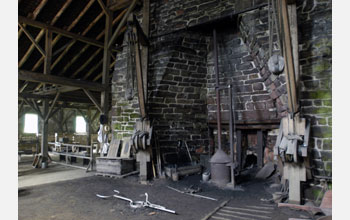Multimedia Gallery
Protecting the Liberty Bell (Image 2)
Protecting the Liberty Bell (Image 2)
The enormous forging area at Hopewell Furnace National Historic Site where the actual metal work to cast a new bell would have been done when the foundry was in commercial operation. Metalwork is still done there in a modified form today to demonstrate for visitors the techniques of colonial artisans.
On Oct. 9, 2003, wireless sensors--developed with support from the National Science Foundation (NSF)--monitored stress on the Liberty Bell as it was moved to its new home at the National Park Service's Liberty Bell Center, located at 6th Street between Market and Chestnut Streets in Philadelphia. A Vermont company, MicroStrain, provided the gauges and monitoring system for free. The technology was developed in part with support from NSF's Small Business Innovation Research program.
To learn more about the Liberty Bell's move and history, see the NSF Special Report The Liberty Bell: Protecting an American Icon. (Date of Image: 2003) [One of several related images. See Next Image.]
Credit: Peter West, National Science Foundation
Images and other media in the National Science Foundation Multimedia Gallery are available for use in print and electronic material by NSF employees, members of the media, university staff, teachers and the general public. All media in the gallery are intended for personal, educational and nonprofit/non-commercial use only.
Images credited to the National Science Foundation, a federal agency, are in the public domain. The images were created by employees of the United States Government as part of their official duties or prepared by contractors as "works for hire" for NSF. You may freely use NSF-credited images and, at your discretion, credit NSF with a "Courtesy: National Science Foundation" notation.
Additional information about general usage can be found in Conditions.
Also Available:
Download the high-resolution JPG version of the image. (3.1 MB)
Use your mouse to right-click (Mac users may need to Ctrl-click) the link above and choose the option that will save the file or target to your computer.

